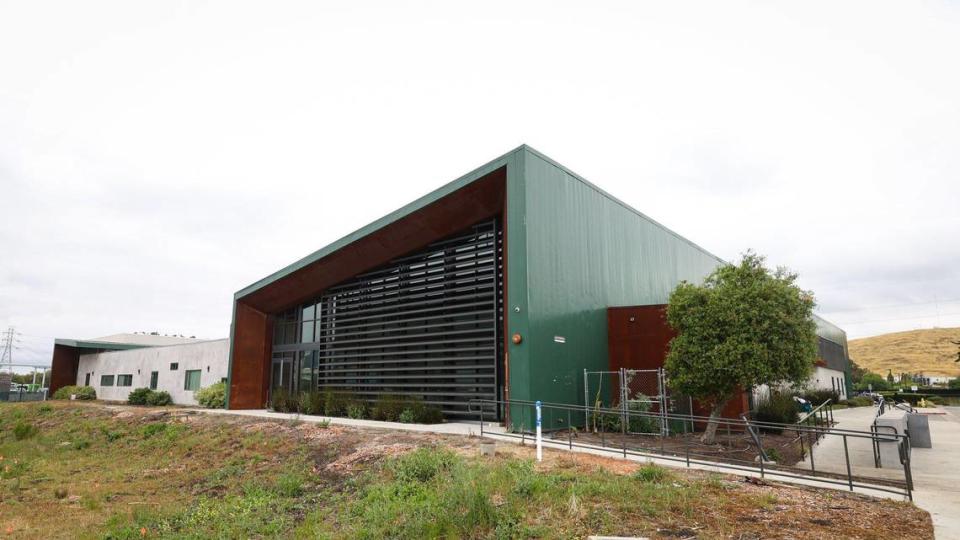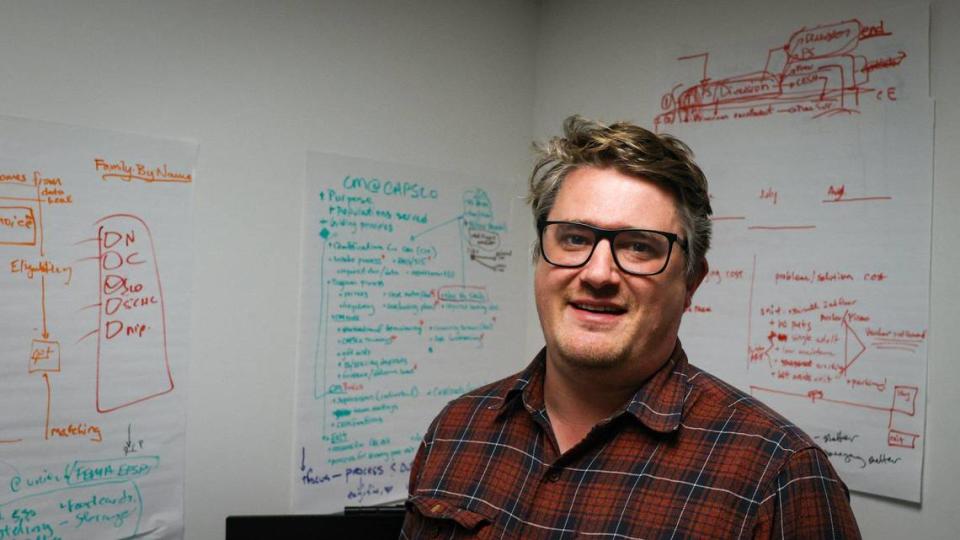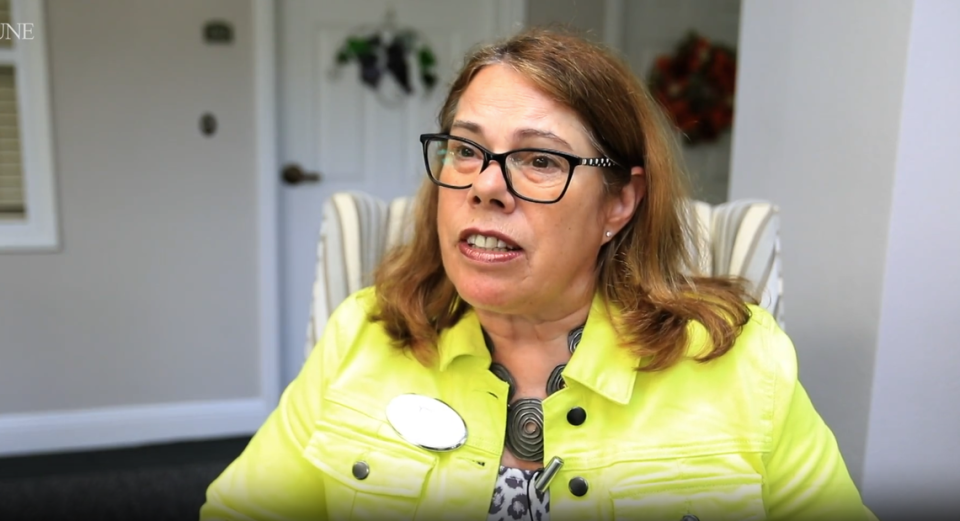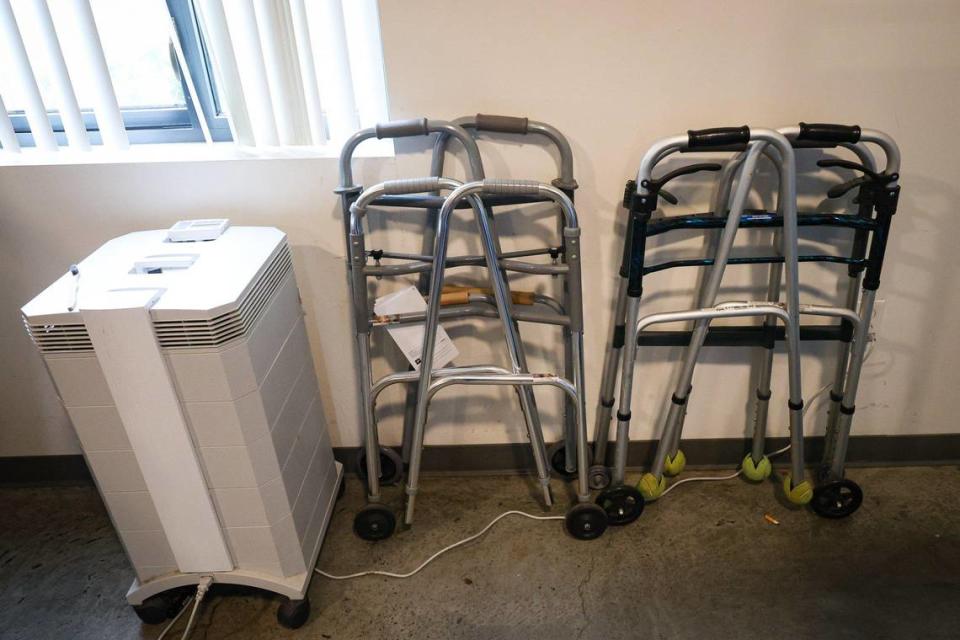‘This is my last move’: SLO County seniors face high costs of living, threat of homelessness
Each morning, Denise wakes up in her bed at 40 Prado Homeless Services Center and starts her day’s routine.
First, she waits for an opportunity to use the shelter’s shower that accommodates people with disabilities. That’s followed by another wait in the breakfast line, before she spends the rest of the morning tackling her daily cleaning chore.
After lunch, Denise, 73, said, the day slows down. Because of her physical limitations and age, she’s permitted to stay in the dormitory area and lie down during the shift change in the middle of the afternoon.
“I almost never sleep,” Denise said of the rest time. “Then, ta-da! It’s time to get ready for dinner. There’s nothing you can do.”
She may socialize with other residents in the evening, and then it’s off to bed around 9 p.m.
The next day, the whole cycle restarts again, just as it has since Denise started staying at the shelter several years ago.
Homeless for the past seven years and more than 100 spots down on the waitlist for housing, she doesn’t see her living situation changing anytime soon.
It’s problem that’s becoming increasingly prevalent for vulnerable San Luis Obispo County seniors, as the realities of an aging population collide with a lack of affordable housing.
“I’m 73 years old,” said Denise, who used a pseudonym due to privacy concerns. “I’m not moving anywhere — this is my last move.”

Senior homelessness rising with cost of living
Denise’s struggles with SLO County’s high cost of living date back to her arrival on the Central Coast almost two decades ago.
Originally from Cleveland by way of Arizona and Sacramento, Denise said she’s had health issues from a young age. Born with spina bifida and dropped at the age of 3 months, she has dealt with mobility problems all her life.
After 20 years working as a costume designer, Denise said a job-related back injury effectively ended her ability to work. That’s when she visited San Luis Obispo on a four-day trip and decided to move here.
Arriving in 2005, Denise said she was able to obtain a Section 8 voucher due to her disability within around three months of her arrival.
The voucher allowed her to live in Arroyo Grande for the next 11 years, she said. But that all changed, she said, when her landlord kept raising rents to keep up with increases in the value of the voucher.
“He got mad, and he’s started throwing people out,” Denise said. “His excuse was he needed to renovate my mobile home.”
Out of options and homeless, Denise said she tried living in Arizona again, but eventually returned to San Luis Obispo County due to California’s higher Supplemental Security Income. Since returning, she’s primarily stayed at 40 Prado, working with case managers and searching for housing opportunities.
Jack Lahey, homeless services manager at 40 Prado, said around 25% of the shelter’s population is comprised of people over the age of 55, a figure that has crept upwards over the past few years.
The Department of Housing and Urban Development’s guidelines do not prioritize housing seniors in subsidized housing, despite the increased chance of medical vulnerability, Lahey said.
Lahey said seniors are also more likely to score lower on HUD’s Vulnerability Index, a metric that determines risk and prioritization needs for homeless individuals, because that metric does not account for age.
“The oldest person on our by-name list is 82 years old, and they scored a 2 out of 17, which by our criteria ... (means) there would be no housing intervention provided to that person,” Lahey said.
Lahey said at 40 Prado, seniors are generally given preference for beds over other younger clients, who may be more physically capable of staying unsheltered.
As part of that prioritization, one of 40 Prado’s five family shelter rooms was converted into a living space for senior and medically fragile women, Lahey said.
Since Lahey joined CAPSLO in 2021, senior homelessness has been a growing issue, and now, the system is straining to accommodate the heightened demand for services, he said.
“We’ve been saying, ‘Oh, this silver tsunami is coming,’ but it seems like now it’s here and we’re in it, and we haven’t really done too much to address it,” Lahey said.

High cost of living takes heavy toll on seniors
Denise is far from the only senior in San Luis Obispo County experiencing or at risk of homelessness.
According to the San Luis Obispo County 2022 Homeless Point in Time Count Report, senior homelessness is on the rise here. Between 2019 and 2022, the share of people aged 51 to 60 experiencing homelessness grew from 15% of the unhoused population to 26%, while the share of people over the age of 61 grew from 8% to 18%.
Those increases in senior homelessness coincide with rising costs of living and an increased demand for affordable senior housing of every type, SLG Senior Care senior placement specialist Sue Gibson told The Tribune.
Gibson said there are around 110 senior living communities and care facilities in San Luis Obispo County — 86 converted homes with around six beds on average and 24 larger care facilities — and prices at these facilities are almost always out of reach for people on a fixed incomes.
“I probably get at least three to five calls a week, with people that have $1,200 to $1,600 a month income and are in need of assisted living,” Gibson said. “There’s calls every single week (in which) I have to say to people, ‘Unfortunately, there is nothing for you, you’re going to have to stay at home with family.’”

In Denise’s case, she gets around $1,200 each month in Social Security and SSI benefits. She also receives Supplemental Nutrition Assistance Program benefits, though she said the amount received has recently dropped from more than $200 to around $23 after increased COVID-19 funding for the program ran out.
Gibson said San Luis Obispo County is not yet a part of California’s Assisted Living Waiver program, which would permit seniors to use their Medi-Cal benefits to obtain assisted living.
However, that’s far from a cure-all for this problem anyhow, Gibson said. In counties where the program has already been implemented, it’s only added a few beds, and waitlists can be years long.
For seniors such as Denise who are already several years into a wait for housing vouchers or a place to call home, Gibson said this delay can be extremely damaging to their health.
Homelessness makes consistently staying on medications far more difficult, causing many seniors to go unmedicated and unable to deal with conditions such as high cholesterol, which is common in the lower-quality nutrition often found at shelters and on the street, Gibson said.
Mobility, sight and hearing impairments are also common among homeless seniors, largely due to the physical stress of inconsistent sleep and constant movement, Gibson said.
Likewise, cognitive function is worsened by prolonged homelessness, including conditions such as dementia and Alzheimer’s, making care even more difficult, Gibson said.
Denise, who is gluten intolerant, said she has lost nearly 40 pounds in 2023 between hospitalizations for bronchitis and subpar gluten-free food at the shelter.

Housing efforts still far behind demand
Efforts to improve housing options for seniors in recent years have accelerated in San Luis Obispo County, but there is still a significant lack of housing that’s affordable to fixed-income seniors.
Elaine Archer, director of housing management at the Housing Authority of San Luis Obispo, said the marginal, 1-2% increases in fixed-income sources such as Social Security and SSI have not kept pace with local rents.
“I think what compounded the issue is that during COVID-19, when the real estate market really took off, it became attractive for people to sell their longtime holdings and cash in on their capital gains,” Archer told The Tribune. “A lot of what has been affordable homes for seniors got sold.”
Seniors are most likely to live in single-family or one-bedroom homes, as most do not live with their immediate family. And that type of housing is almost never available in San Luis Obispo County, Archer said.
Archer said the last time she conducted an analysis of HASLO’s waiting lists in February, more than 1,800 people were waiting to get into one-bedroom units.
She estimated more than 50% of those applicants were elderly or disabled, and demand for one-bedroom units was double that of two-bedroom units.
Building more affordable housing for seniors presents some unique design challenges, which led HASLO to include a requirement of making all ground-floor units adaptable for wheelchair users, Archer said. The organization’s senior affordable housing units almost always include an elevator, she said.
“When we build multifamily (housing), I’ve asked our development team to dedicate as many units as we can to the one-bedroom category,” Archer said. “We’re a retirement community — Morro Bay, South County — people retired here, and we don’t have enough one-bedroom units across the board.”
People’s Self-Help Housing, another of the county’s largest affordable housing providers, has also seen demand spike in recent years, CEO Ken Triguiero told The Tribune.
Triguiero said for every one-bedroom, senior-specific unit People’s Self-Help Housing produces, there are around six seniors on the waiting list. To meet demand, the county needs at least 3,500 units, he said.
Despite the organization’s efforts to increase affordable housing for seniors, applicants on the list are still experiencing waits of around five years, Triguiero said.
“We’re trying to understand the demographics of the folks who are telling us they need this affordable housing,” he said.
As a means of meeting demand, People’s Self-Help Housing is targeting fewer of its projects to one group of people who need affordable housing, instead opting to build more adaptable, generally applicable units, Triguiero said
Similar to HASLO, many of People’s Self-Help Housing’s new multifamily projects that feature one-bedroom units place those units on the ground floor and are built with Americans with Disabilities Act-compliant doors that can accommodate wheelchairs and walkers, Triguiero said.
“If we’re not providing all the accessibility in a new project, we’re at least thinking in the future (that) we might want to convert those, and so we make them ADA-adaptable,” Trigueiro said. “As a senior goes in there, and then lives there over time, they might experience a disability, (and) we can convert that unit pretty easily.”
What’s next?
As it stands, Denise said she doesn’t believe she’ll be housed anytime soon.
Having lived alone all her life, she said she’s not interested in living in the kind of collective housing that most homeless service providers use to place clients in transitional housing.
That limits her options and has been a sticking point in getting her out of the shelter, she said.
She said she’s “frustrated beyond belief” with the lack of progress toward housing she’s made in recent years, and is sure the feeling is mutual with her case manager.
“Now it’s a waiting game — I’m on the list, and if a whole lot of people die, I’ll get an apartment,” Denise said.

